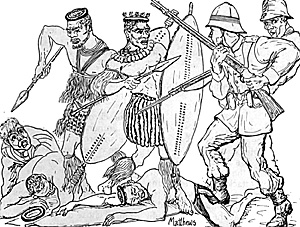 Bob Wiltrout and Wally Simon of the Potomac Wargamers engaged in a simple British Colonial campaign, designed to be completed in one afternoon's worth of play.
Bob Wiltrout and Wally Simon of the Potomac Wargamers engaged in a simple British Colonial campaign, designed to be completed in one afternoon's worth of play.
Single mounted figures were used, each slightly larger than 30mm in height. Unit sizes were purposely kept small, i.e., one to two man squads . . . this was dictated by the fact that there were only some 20 British and 40 Zulu figures available.
Figure 1 is a sketch of the region on which the campaign was played. There are 4 key locations on the map: the waterhole, the fort, and 2 farms. Each area is linked to the next by a system of roads; while the British columns were restricted to these roads, the Zulus were not . - . a Zulu path will be noted traversing the map, giving the Zulus an edge in mobility.
The campaign was an exercise in the tactical assignment of troops. Each side was given a small force and had to station units to its best advantage. The Zulu goal was, in general, destruction: they could gather victory points by burning the farms, poisoning the waterhole, capturing the fort, and knocking off the British. Victory points for the British could only be gained by eliminating Zulus. Point allocation was as follows:
- Burning a farm 10
Poisoning the waterhole 10
Capturing the fort 15
Killing an enemy 1
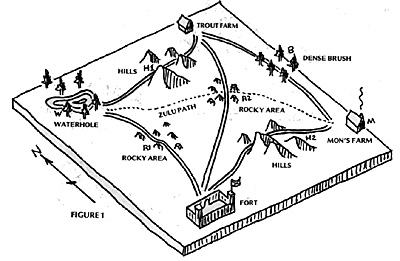 The campaign was over the instant either side totaled 32 points.
The campaign was over the instant either side totaled 32 points.
Each move was noted on the campaign map, after which the British would announce the location-but not the number-of their men. if a Zulu force was colocated at the same position as that of a British unit, the Zulus had the option of attacking or remaining hidden and letting the British pass unharmed. If the Zulus decided to remain undetected, a small probability was assigned to the possibility that the British might spot the hidden unit of warriors.
Total force size was as follows:
British:
- 1 Gatling gun + 3 man crew
18 troops
2 Officers
Zulu:
- 5-man unit bearing muskets
35 warriors
3 Chiefs
British forces took 2 campaign moves to cover the distance between 2 adjacent circled areas; the Zulus could traverse the same distance in one move.
A dice throw decided that Colonel Wiltrout would command the British contingent, while Zimbu Simon, the Lion of Zululand, led the uprising.
For Turn 1, Zimbu allocated 10 men to the dense brush B, another 10 men in the hills H1, and a large force to rocky area R1. He was thus in position, once he found out the location of the British units, to strike at either farm or the waterhole.
Your chronicler was not privy to Colonel Wiltrout's assignments, but it appeared that the bulk of the British forces were clustered near the fort. The history of the campaign was gathered from a series of discussions with Zimbu, and that good fellow could only speak for himself.
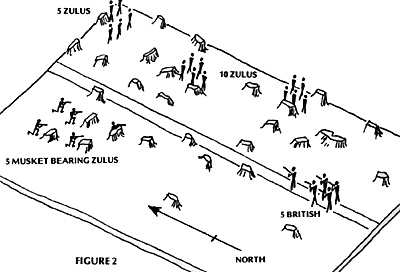 What was known, however, was that the Colonel sent out a small 5 man patrol to rocky area R1, and that Zimbu chose to attack the unit with a force of 20 men, including his 5 musket bearing warriors.
What was known, however, was that the Colonel sent out a small 5 man patrol to rocky area R1, and that Zimbu chose to attack the unit with a force of 20 men, including his 5 musket bearing warriors.
Figure 2 shows the initial location of the opposing forces. The British patrol leader, Lieutenant Williston Wiltrout 111, a nephew of the Colonel's, upon sighting the enemy, immediately ordered his men to take cover amongst the rocks. At this point in time they had only noted the Zulus to the east of the road. The Lieutenant then ordered his men to try and fight their way past the opposition, when suddenly the musket bearing troops opened fire on them, blocking the route north.
Figure 3 displays the nomograph used to ascertain firing casualties. It will be noted that range, cover, the number of men firing, and whether or not the fire was "hasty", are all combined to give the total of enemy casualties inflicted.
Lieutenant Wiltrout's men were finally forced back down the road to the south, towards the fort, meeting a small relief column that the Colonel had sent out upon hearing the shots fired as the patrol fought off its attackers.
Although the Lion's warriors had killed 2 men of the 5 man patrol, the Lion had suffered 8 casualties . . . including 1 Chief, and 4 of his musket bearing troops.
A very costly encounter. Several more such "victories" of this sort and Zimbu the Lion would not even bother to run in the next Zulu election.
Making the best of his situation, however, Zimbu, on the next campaign move, took his group north to the waterhole, and at the same time, ordered his men at areas H1 and B to converge on Trout's farm. Campaign Turns 3 and 4 were spent burning down the Trout bungalow, and poisoning the waterhole . . . for ' it seemed, there were no British defenders at either location. Turns 5, 6, and 7 were then used to permit all available Zulus to gather at area R2, readying themselves for the grand assault on Mon's farm.
While the Zulus were gathering, Colonel Wiltrout, short on men, was in a dither. He sent out his Gatling gun to the hill area H2, and then thought better of the idea, and recalled the unit to the fort. The Zulus had earned 22 Victory Points at this time (2 British killed, and 10 points each from Trout's farm and the water- hole) and were only 10 points away from running away with the campaign. The next obvious target was the 10 point Mon's farm location . . . yet the Colonel didn't trust Zimbu to do the obvious; it was just possible, thought the Colonel, that the next target would be the fort itself. And so back to the fort went the Gatling gun to reinforce the garrison.
The Colonel did, however, send out a 2 man patrol from Mon's farm along the Zulu path towards rocky area R2, where Zimbu and his friends were sharpening their spears. On Campaign Turn 8, this patrol spied the oncoming Zulus and began to backpedal as fast as they could, keeping up a steady "hasty" fire as they retreated.
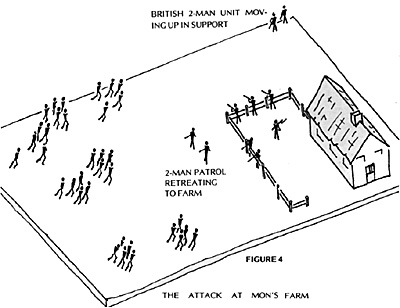 Figure 4 details the terrain at Mon's farm. Occupying
the grounds were one officer, Captain Horton M.
Thwackerbush, and 5 men. The map also indicates a
2 man unit making its way to assist "Horty" (as his
men fondly called him) and his boys from hill area H2;
these, together with the rapidly retreating men who
had first spotted the Zulus, made a total of 10 British
stalwarts who were to take part in the battle.
Figure 4 details the terrain at Mon's farm. Occupying
the grounds were one officer, Captain Horton M.
Thwackerbush, and 5 men. The map also indicates a
2 man unit making its way to assist "Horty" (as his
men fondly called him) and his boys from hill area H2;
these, together with the rapidly retreating men who
had first spotted the Zulus, made a total of 10 British
stalwarts who were to take part in the battle.
The forces of Zimbu the Lion consisted of every Zulu under his command, a total of 35 warriors. This was make or break for the Lion.
Despite heavy losses, the Zulus finally closed with the soldiers in the farmyard, some engaging the men protected by the fence surrounding the yard, others leaping the fence seeking to surround the defenders. Horty was an unhappy man ... it seemed as if the en- tire Zulu nation-all 35 of them-was descending on his position.
For purposes of morale, the oncoming Zulus were divided into groups of 5 figures, each small unit checking its staying power whenever it suffered a loss. A 10-sided die was used, and the morale rules were quick and effective: if the unit had 1 casualty, a roll of 1 would cause them to waver; 2 casualties needed a throw of 1 or 2; 3 casualties required a 1, 2, or 3, etc. Thus only small groups of Zulus would be affected by any one morale check, while the horde's advance would, in essence, remain unchecked. Suffice it to say that, due to the fine training received by Zimbu's men, only one group failed its morale check during the long, bloody charge across clear ground as the Zulus converged on the British.
Horty's men at the fence line were given 2 dice to throw: a 10-sided die for being British, and a 6-sided die for the protection offered by the fence. The attacking Zulus were each given a 12-sided die. A difference of 2 between the two opposing throws was required for a kill, a difference of one was considered a standoff.
The men at the fence, bolstered by their extra 6-sided die, held out in good fashion, even though they were slowly being whittled down by an occasional good Zulu die toss. Horty and one other man assigned themselves to counter the Zulus that had jumped over the fence, and both did excellent work. Horty, being an officer of Her Majesty, was given a 12-sided die, making him equal in combat to any of the Zulus.
Despite the fierce British defense, Zimbu was confident; he had the odds in manpower and, he thought, he could afford to lose a few troops as long as the enemy was suitably clobbered. Zimbu's confident manner increased slightly as one of his larger warriors finally overcame Horty in the farmyard . . . the British were now leaderless.
And, suddenly, in the midst of the melee . . . Zimbu the Lion's luck ran out. The British were down to their last 3 men, when the voice of Colonel Wiltrout was heard echoing above the din of battle: "Zimbu, old fellow, I do believe that you've now lost 32 men since the campaign began. Do you realize what that means?"
Yes, Zimbu knew what that meant. A total of 32 Victory Points for the British. Victory snatched from Zimbu's grasp . . . just 3 British soldiers too late. Hard cheese, indeed!
But victory or no, the campaign effort succeeded in all that it set out to do. It furnished an appropriate backdrop for a rapid series of small encounters which could be enjoyed at one sitting.
At campaign's end the final totals were:
- British: 3 men at Mon's farm
British: 11 men at the fort
Zulu: 7 proud warriors somewhere in the hinterland
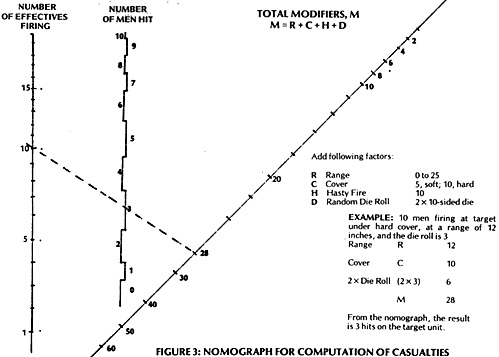
Back to Table of Contents -- Courier Vol. V #3
To Courier List of Issues
To MagWeb Master Magazine List
© Copyright 1984 by The Courier Publishing Company.
This article appears in MagWeb (Magazine Web) on the Internet World Wide Web.
Other military history articles and gaming articles are available at http://www.magweb.com